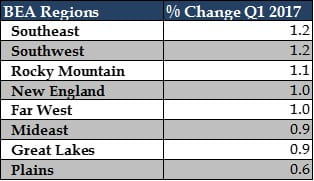BEA Numbers Show State Personal Income Growth Higher than Previous Quarter
The Bureau of Economic Analysis released its state personal income numbers for the first quarter of 2017. State personal income growth accelerated to 1.0 percent on average in the first quarter of 2017 from 0.3 percent in the fourth quarter of 2016. Earnings and personal current transfer receipts were the leading contributors to growth for the nation and in most states.
Personal Income grew 1.6 percent in Idaho, faster than in any other state. Four other states–Louisiana, Michigan, Florida, and Texas–had the next fastest growth in personal income at 1.3 percent. Kansas, Minnesota, North Dakota, and Iowa had the slowest growth, and Nebraska at -0.1 percent was the only state where personal income declined. The BEA also breaks down state personal income growth by industry. In non-governmental sectors, the highest growth rate of any industry in any state belongs to Texas, which had personal income growth of 4.03% in Arts, Entertainment, and Recreation. The slowest growth was in the state of Utah, in which personal income in Management of Companies and Enterprises had a negative growth rate of -6.02%.
The BEA estimates shows how much a state’s income has risen or fallen in the first quarter of 2017. The BEA measures state income as the sum of net earnings by place of residence, property income, and personal current transfer receipts. Net earnings are wages, salaries, and current benefits like employer provided healthcare. Property income includes rental income, but also stock dividends and other interest income. Current transfer receipts include any benefits received from Federal, state, or local government, as well as private pensions. The map below shows the growth for each state, and it is notable that all five slowest growth states are in the BEA Plains region.
Below is a chart of the state personal income growth in Q1 2017 for each region. The Plains region reflects its states’ poor growth, growing at the slowest rate of 0.6%. The Southeast and Southwest both grew at a leading 1.2%. Overall, the regions are quite close in their growth rates, with the exception that the Plains states grew at a noticeably slower pace overall.
 It is important to note that this report does not include the wage-growth numbers commonly reported by the media. Those numbers are collected and reported by the Bureau of Labor Statistics, and the focus is specifically on wage earners. The report on income from the Bureau of Economic Analysis takes a much broader look at income overall. Access to the BEA’s full data on state income changes Q1 2017 can be found here.
It is important to note that this report does not include the wage-growth numbers commonly reported by the media. Those numbers are collected and reported by the Bureau of Labor Statistics, and the focus is specifically on wage earners. The report on income from the Bureau of Economic Analysis takes a much broader look at income overall. Access to the BEA’s full data on state income changes Q1 2017 can be found here.
All data provided by the U.S. Bureau of Economic Analysis
by Jeffrey L Garceau

